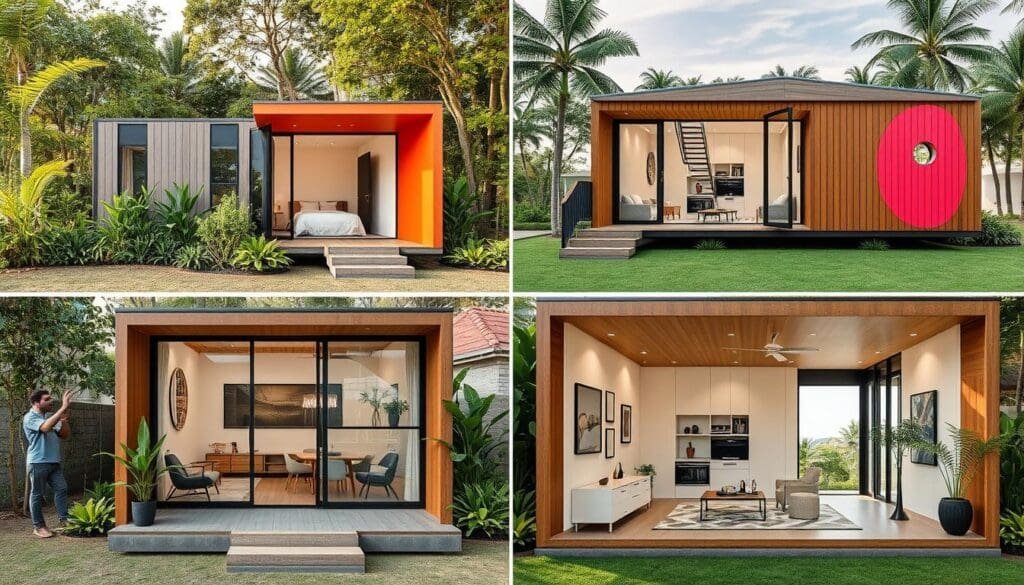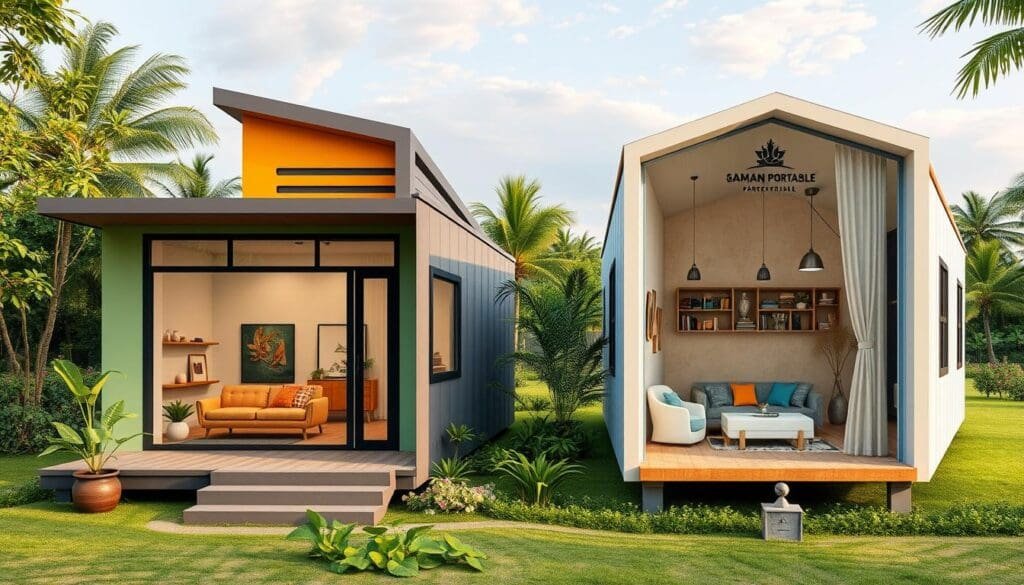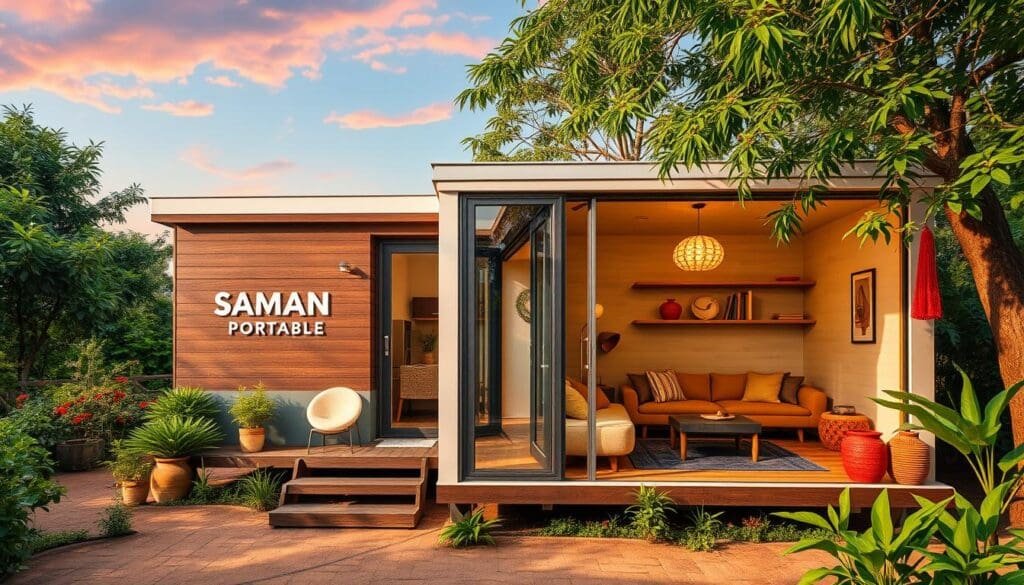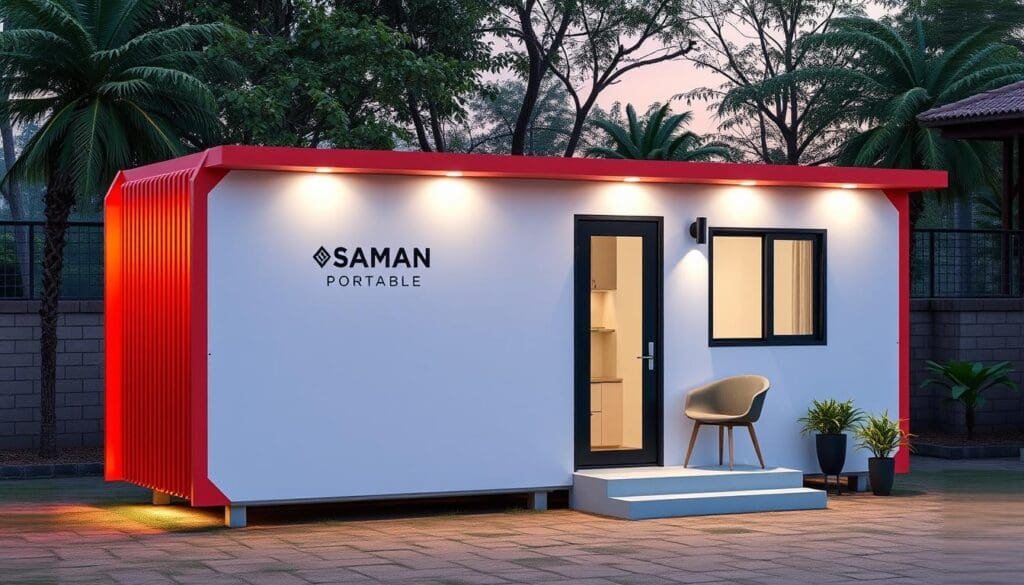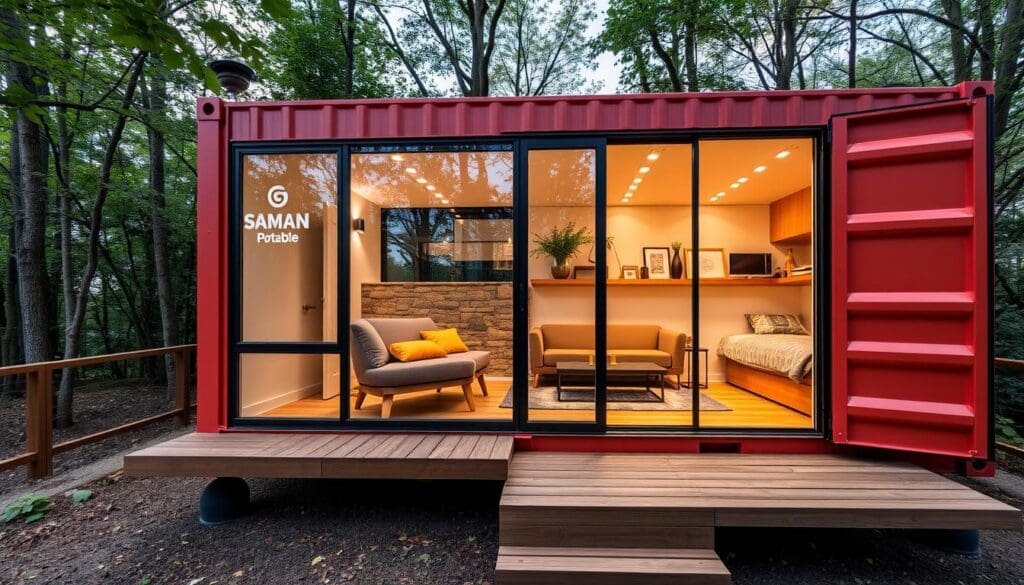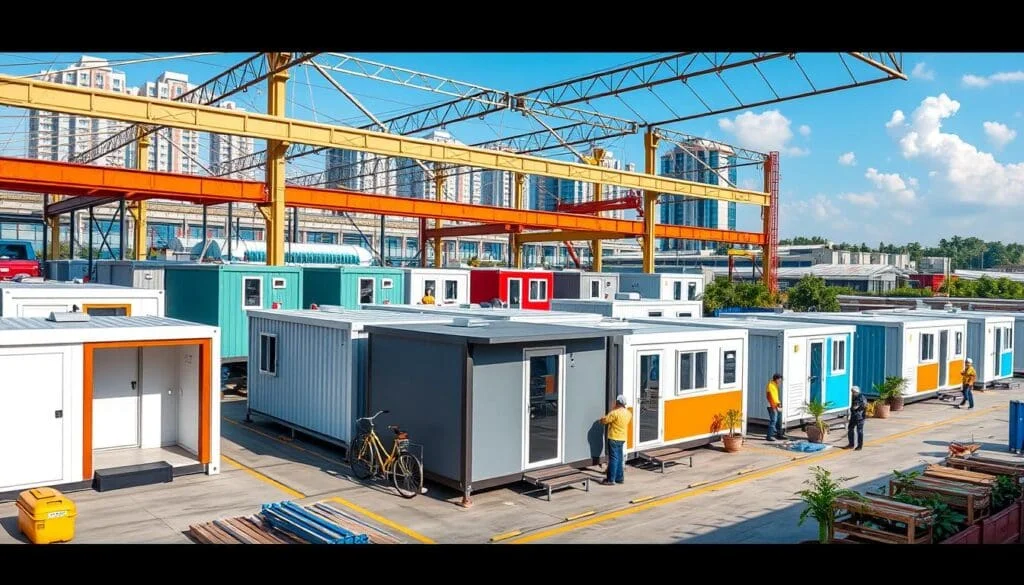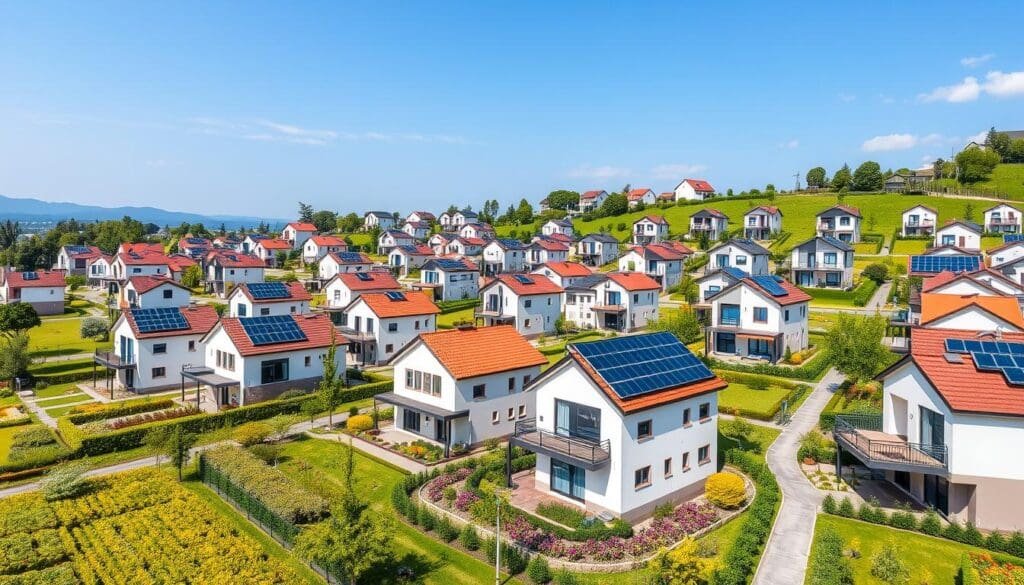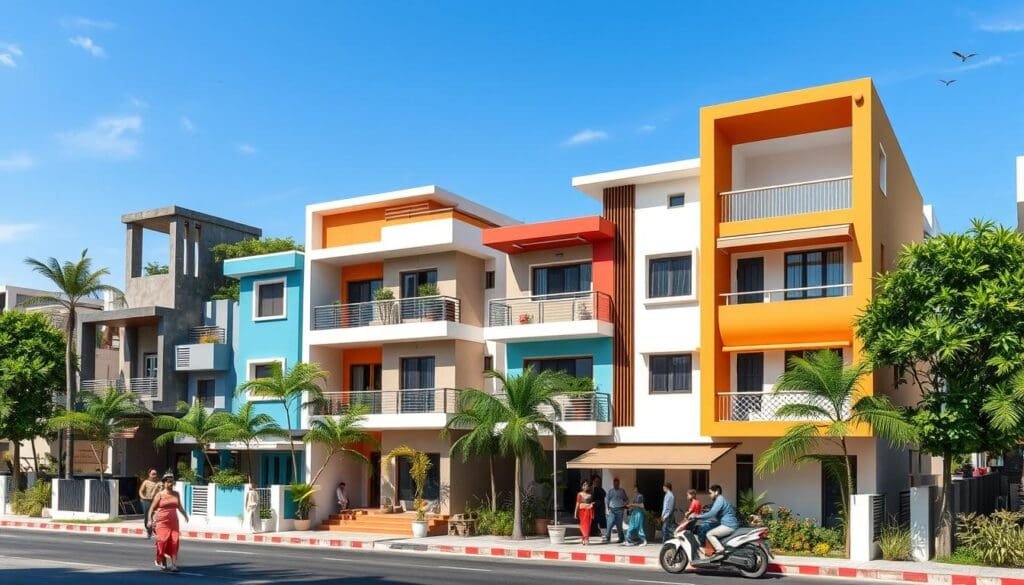Benefits of Prefabricated Homes Over Traditional Housing: Why Modular Homes are the Future
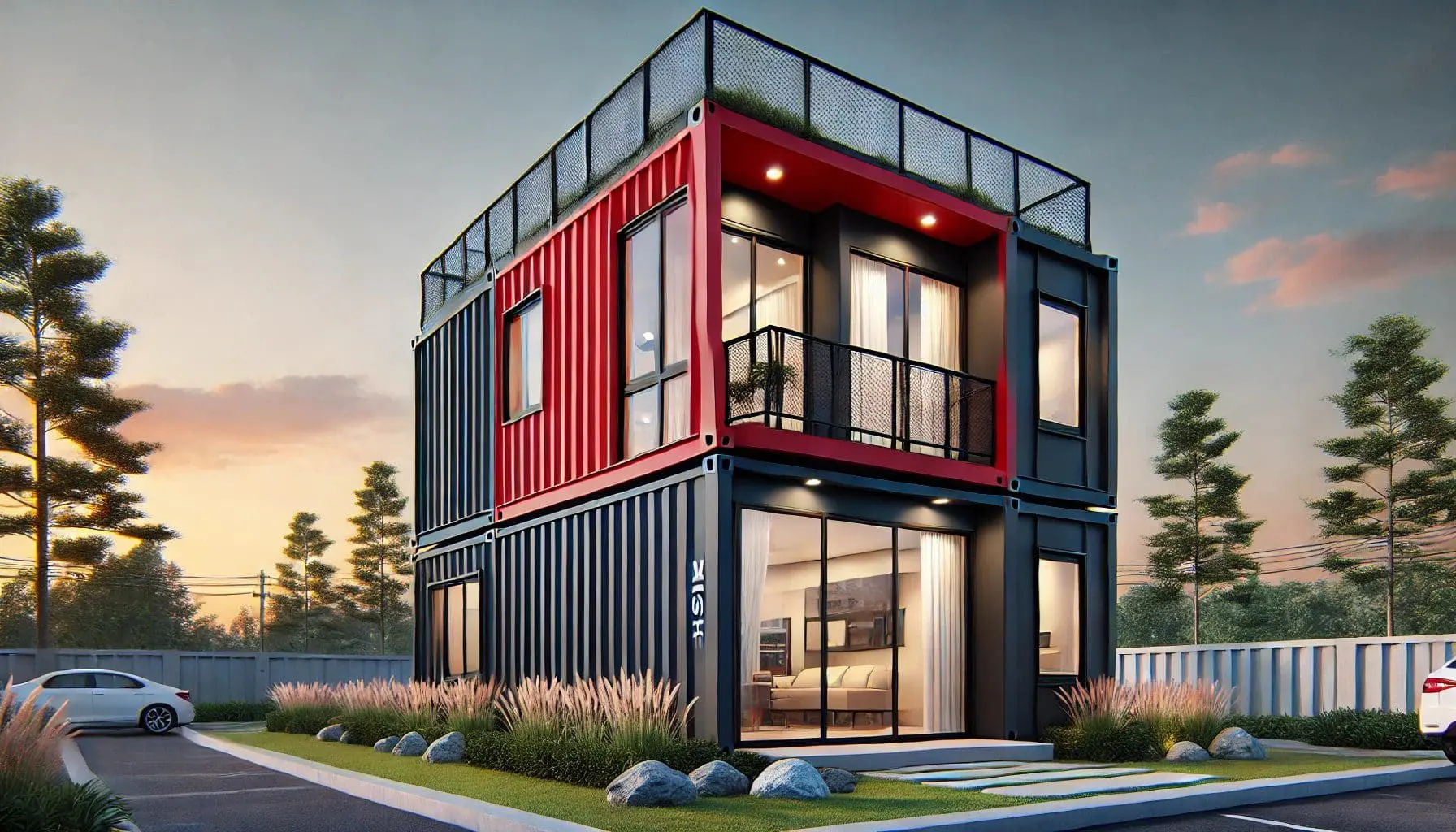
Introduction: Understanding Prefabricated Homes vs. Traditional Housing
What Makes Prefabricated Homes Different from Traditional Homes?
Prefabricated homes, also known as modular homes, are constructed off-site in controlled environments and then transported to the designated location for assembly. This contrasts sharply with traditional housing, where the entire building process takes place on-site, requiring longer timelines and often higher costs. Prefabricated homes, such as Saman Portable’s container homes and modular housing, are designed to provide faster construction, cost-efficiency, and flexibility, making them an increasingly popular choice in India.
In traditional housing, construction delays are common due to on-site weather conditions, material shortages, and other unforeseen issues. However, prefabricated homes are built in a factory setting, ensuring that production is not subject to external factors. As a result, modular homes can be assembled in a fraction of the time required for conventional builds, offering a quicker path to occupancy. Saman Portable’s prefabricated units and portable cabins offer quick and reliable solutions for both residential and commercial needs, offering a significant advantage for people looking to move into their new spaces sooner.
Key Advantages of Prefabricated Homes
The key benefits of prefabricated homes over traditional houses include shorter construction time, cost efficiency, customization options, and reduced environmental impact. For example, portable cabins from Saman Portable are excellent for temporary office setups or residential housing, offering a flexible and affordable solution. Furthermore, prefabricated homes are customizable, allowing for the inclusion of specific layouts, finishes, and features that cater to the buyer’s individual needs.
Prefab homes are also built using sustainable practices and materials, contributing to lower carbon footprints and energy consumption. The precision of the factory-based manufacturing process leads to less material waste, a key advantage when compared to conventional construction methods that often result in a significant amount of discarded materials. These environmentally conscious benefits align with growing global trends toward sustainability and eco-friendly living.
For an in-depth understanding of prefab homes, refer to Prefabricated House in India Benefits.
Why Prefabricated Homes Are the Future of Housing in India
As India faces rapid urbanization, the demand for affordable, durable, and customizable housing solutions continues to rise. Prefabricated homes meet these demands by offering quick, high-quality construction at a fraction of the cost of traditional methods. With increasing government support and awareness, the adoption of modular housing in India is expected to grow, helping to alleviate the housing shortage in both urban and rural areas.
Saman Portable’s range of products, such as porta cabins and prefabricated homes, are setting new standards for affordable housing in India, offering a practical and stylish alternative to traditional construction methods. For more information on Saman Portable’s vision and their wide range of products, visit their about us page.
Speed of Construction: How Prefabricated Homes Save Time
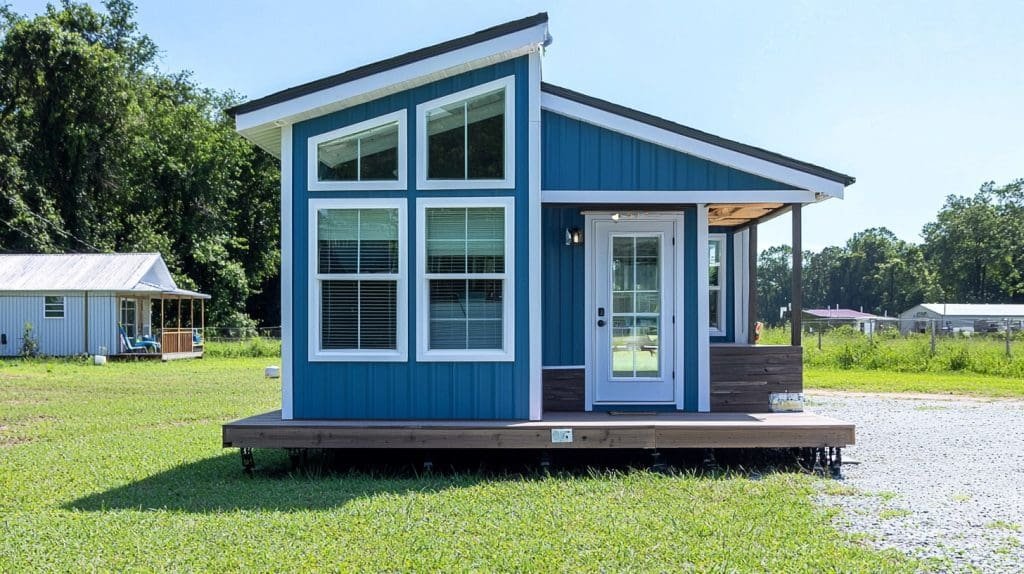
Faster Turnaround Time for Prefabricated Homes
One of the most compelling reasons to choose prefabricated homes over traditional housing is the speed at which they are built. Traditional homes can take months or even years to complete due to factors like labor shortages, weather delays, and the time-consuming nature of on-site construction. In contrast, modular homes are manufactured off-site in a factory, allowing for much faster production and assembly. Once the modules are built, they are transported to the site and assembled in a matter of weeks, rather than months, saving homeowners and businesses valuable time.
Prefab units are designed to minimize on-site construction time, with many components pre-installed at the factory, including plumbing, electrical wiring, and insulation. For example, Saman Portable’s container homes and prefabricated housing are designed to be assembled quickly, ensuring that homeowners can move in and begin living in their new spaces almost immediately after delivery.
Less Time in Manufacturing and Assembly
The modular manufacturing process allows for efficient scheduling and quicker turnaround times. Since the building materials are prefabricated in a controlled environment, construction can happen without the interruptions that often plague on-site building. This efficient system also helps reduce labor costs, as less time is spent on-site, allowing workers to focus on final assembly rather than managing complex, time-consuming construction processes.
Additionally, since the manufacturing process happens in parallel with site preparation, there is no need for the delays that typically occur when waiting for materials to arrive or when workers are waiting for the weather to improve. Saman Portable’s porta cabins and portable cabins offer the flexibility to be set up quickly and efficiently, whether for temporary accommodations or as permanent living spaces.
Explore the Prefabricated House Construction Process for insights into the building stages.
The Convenience of Prefabricated Homes in Urban and Rural Areas
In both urban and rural settings, the speed of prefab homes offers distinct advantages. In urban areas, where space is often limited and the need for quick, efficient housing is urgent, prefab homes can provide a fast solution to meet housing demands. Modular homes and prefab units can be installed in areas with limited space, giving families or businesses the flexibility to build on smaller plots of land. In rural areas, where access to skilled labor and building materials may be limited, prefabricated homes ensure that high-quality housing can be constructed quickly and affordably.
By reducing construction time, prefabricated homes help alleviate the housing shortage in both urban and rural India, providing affordable, quick solutions for families and businesses alike. The ability to complete a project in a fraction of the time it would take for traditional construction makes prefab homes a game-changer in the housing sector.
Cost Efficiency: Saving Money with Prefabricated Homes
How Prefabricated Homes Are More Cost-Effective Than Traditional Construction
Prefabricated homes are a cost-effective alternative to traditional housing, offering significant savings in both construction and long-term maintenance. One of the primary ways prefab homes save money is by reducing construction time. With traditional homes, the construction process can be lengthy and subject to delays due to weather, labor shortages, or unexpected issues. However, prefab homes are manufactured off-site in a controlled environment, where production is efficient and unaffected by external factors. As a result, prefab units, like Saman Portable’s container homes and portable cabins, can be assembled in a fraction of the time it takes to build a traditional home, leading to lower labor and material costs.
The streamlined construction process also reduces the need for a large workforce, further lowering costs. Since prefabricated homes are built in factory settings, they are made with precision, minimizing waste and ensuring that materials are used efficiently. This results in significant cost savings, which are then passed on to the buyer. Saman Portable’s modular housing units offer durable, high-quality homes at affordable prices, making them an ideal choice for budget-conscious buyers.
Long-Term Savings: Reduced Maintenance Costs
In addition to lower upfront construction costs, prefab homes also provide long-term savings through reduced maintenance. Traditional homes often require ongoing repairs due to wear and tear, especially if they are built using lower-quality materials. On the other hand, prefab homes are constructed using high-quality materials that are specifically chosen for their durability and resistance to weather conditions. Many prefab homes are built with energy-efficient features such as advanced insulation, high-performance windows, and energy-efficient appliances, which help reduce long-term utility costs.
Prefab homes, like the pre-designed homes offered by Saman Portable, also require less maintenance due to their high build quality and efficient design. This results in fewer repairs and replacements over time, allowing homeowners to save money on upkeep. Additionally, because prefab homes are built to withstand various weather conditions, they tend to last longer than traditional homes, further enhancing their value.
Lower Utility Bills with Energy-Efficient Design
Prefab homes are often designed with energy efficiency in mind, incorporating features like superior insulation, energy-efficient HVAC systems, and solar panel options. These energy-saving features help reduce the home’s overall energy consumption, leading to lower utility bills. For example, Saman Portable’s prefabricated housing solutions can include energy-efficient options like solar panels and high-quality insulation, reducing reliance on external energy sources and cutting monthly costs.
As energy-efficient designs become more common in the prefab housing industry, the savings on energy costs will continue to grow, making prefab homes not only more affordable to build but also more cost-effective to live in over the long term. These long-term savings make prefab homes a smart investment for homeowners and businesses alike.
With reduced construction time, lower labor costs, long-term savings on maintenance and utilities, and the option for energy-efficient features, prefabricated homes offer an excellent value proposition for anyone looking to save money on housing without sacrificing quality or comfort.
Customization and Flexibility in Modular House Design in India
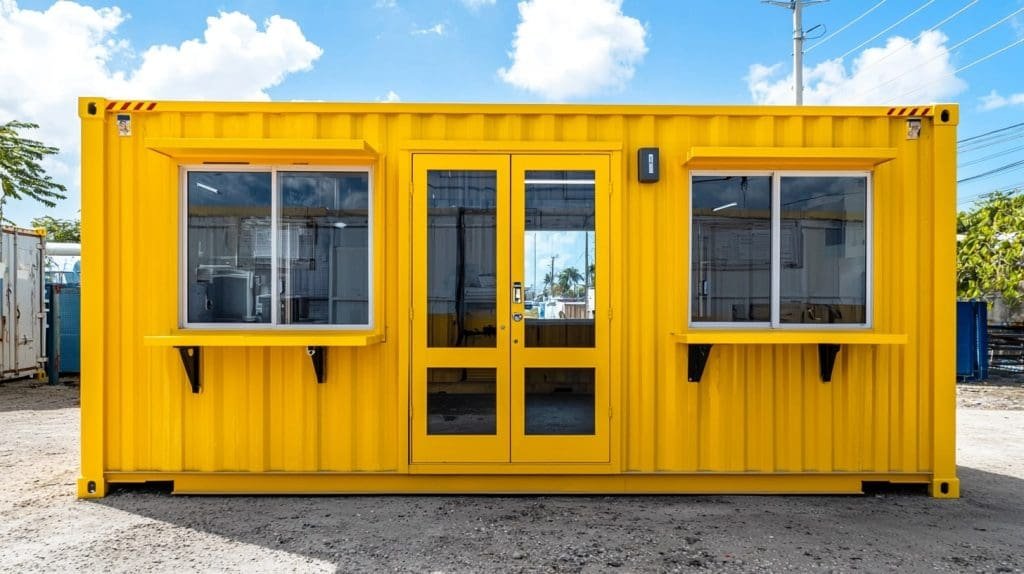
Personalized Modular Home Design Options
One of the standout features of modular homes is the ability to customize and personalize the design to suit individual preferences and needs. Unlike traditional homes, where the design process can be restrictive and costly, modular house design in India allows for a wide range of flexible options. From the layout and room sizes to the finishes and fixtures, modular homes can be adapted to fit the client’s specific requirements. Whether you need a larger living room, additional bedrooms, or a unique style of kitchen, prefab homes offer extensive customization options. Saman Portable’s prefabricated homes are available with various design configurations, offering clients the flexibility to choose floor plans and interior layouts that best suit their needs.
Additionally, buyers can choose eco-friendly materials, energy-efficient systems, and smart home technology to enhance the comfort and sustainability of their homes. This level of customization allows modular homes to be tailored to individual tastes, whether you’re looking for a modern minimalist design or a traditional aesthetic. The ability to adapt the design based on preferences, budget, and needs is one of the reasons why modular homes are becoming increasingly popular in India.
Learn more about customizing modular homes in Modular House Design in India Benefits.
Expanding Living Spaces with Modular Homes
Modular homes offer unparalleled flexibility, especially when it comes to expanding living spaces. Unlike traditional houses, where expanding often requires significant construction work and permits, modular homes can be easily extended by adding new modules. This is particularly advantageous for growing families or businesses that require additional space as time goes on. Saman Portable’s modular housing solutions can be expanded by adding new rooms, converting spaces, or even modifying the layout, all with minimal disruption to the existing structure. This flexibility makes prefab homes a great long-term investment, as they can grow with the needs of the owners.
The ability to expand modular homes not only offers flexibility but also makes them more economical in the long run. Instead of moving to a larger home when your needs change, modular homes can be adjusted to meet your evolving requirements without the cost and hassle of building a completely new structure.
Visit Fabrication House in India Modular Guide for more comparisons.
Innovative Features in Modular Homes for Modern Living
In addition to customizable layouts, modular homes in India are designed to incorporate modern features and innovations. Many prefab homes are equipped with energy-efficient insulation, advanced plumbing systems, smart home technology, and eco-friendly appliances, which enhance both the functionality and sustainability of the home. These features make modular homes a smart choice for homeowners who want to live in a space that reflects modern lifestyles and priorities.
For example, Saman Portable’s container homes often come with energy-efficient insulation and environmentally friendly materials, helping to reduce heating and cooling costs. Furthermore, modern amenities like integrated security systems, smart lighting, and automated temperature controls make living in prefab homes more convenient and comfortable. Whether you’re interested in a sleek, contemporary design or a more rustic feel, modular homes can be built to accommodate a wide range of tastes and modern technologies.
In conclusion, modular homes offer exceptional flexibility and customization, allowing homeowners to create spaces that truly reflect their individual needs and preferences. With the ability to personalize designs, expand living areas, and incorporate modern features, modular homes provide an adaptable, long-term housing solution for a variety of lifestyles.
For eco-friendly housing options, explore Readymade Houses in India Benefits.
Durability and Quality Control in Prefabricated Homes
Built to Last: The Durability of Prefabricated Homes
One of the main reasons homeowners choose prefabricated homes over traditional construction methods is their exceptional durability. Prefabricated homes, like those offered by Saman Portable, are built in a controlled factory environment, where every component is manufactured with precise specifications. The materials used in prefab homes are chosen for their strength and resistance to wear and tear, ensuring that the final structure can withstand the rigors of daily life as well as various environmental factors. Saman Portable’s container homes and modular housing solutions are designed with durability in mind, built to last for many years with minimal maintenance.
Unlike traditional homes that rely on various contractors and can face inconsistent quality control, prefab homes are produced in a factory, allowing for a high level of oversight and consistent quality. This process reduces the risk of errors and defects, ensuring that each home is built to withstand harsh conditions and provide lasting comfort.
Factory-Based Manufacturing Ensures Consistency
One of the key advantages of factory-based manufacturing for prefab homes is the consistency it offers. Since all components, from the walls and flooring to the windows and roofing, are manufactured in a controlled environment, there is a higher level of precision. This ensures that each piece fits perfectly and meets strict quality standards, unlike on-site construction where conditions such as weather or fluctuating labor availability can introduce errors. This consistency means that every part of the prefab home, whether it’s a portable cabin or a larger modular unit, is crafted with the same level of care, ensuring high quality and reliability.
Additionally, the factory environment reduces the risk of defects caused by environmental factors such as moisture or temperature changes, which can negatively impact materials used in traditional construction. With prefab homes, the production process takes place in optimal conditions, resulting in stronger and more resilient homes.
Weather Resistance and Longevity
Prefab homes are built to endure various weather conditions, particularly those in regions that experience extreme temperatures, heavy rainfall, or high winds. The materials used in prefabricated homes are often chosen for their weather-resistant properties, and the design process incorporates elements that help these homes withstand challenges posed by India’s diverse climate. For example, modular homes in India are often designed with durable, weatherproof cladding and high-quality insulation, ensuring the home remains comfortable and secure in both hot and cold climates.
Saman Portable’s prefabricated housing units are tested for strength and weather resistance before being delivered to the site, ensuring that the home can handle everything from heavy rains in coastal areas to high winds in regions prone to storms. The weather-resistant properties of prefab homes reduce the risk of damage from the elements, prolonging the life of the structure and providing homeowners with peace of mind.
In summary, the durability and high-quality control of prefab homes make them a reliable and long-lasting alternative to traditional homes. With factory-based manufacturing ensuring precision, weather-resistant designs for various climates, and the use of strong, durable materials, prefabricated homes offer exceptional value for homeowners seeking both reliability and low maintenance. Whether you choose a portable cabin, a container home, or a larger modular structure, prefab homes are built to stand the test of time.
Eco-Friendly Benefits of Prefabricated Homes
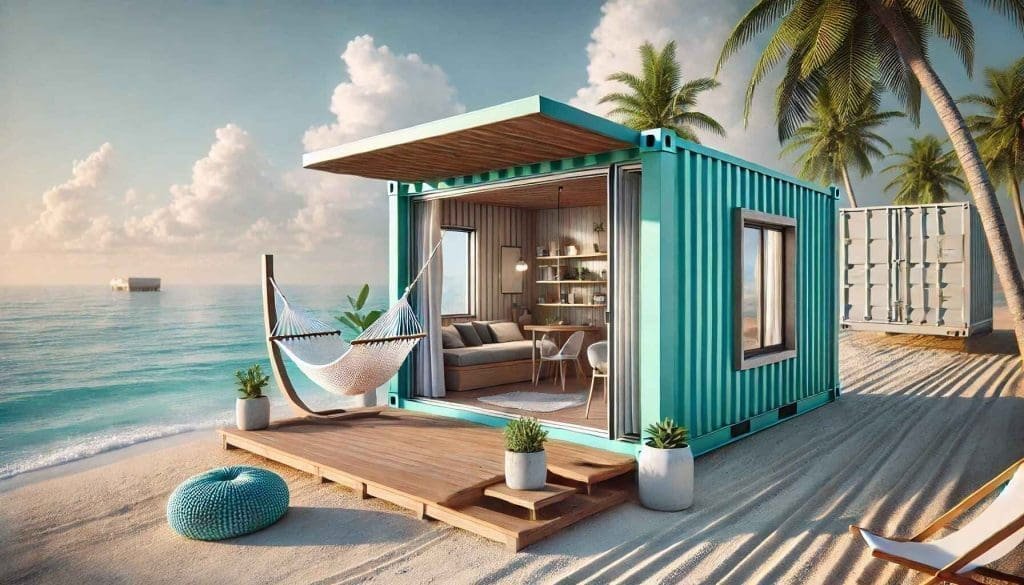
Sustainability in Prefabricated Housing
Prefabricated homes offer significant eco-friendly advantages, making them a great choice for environmentally conscious buyers. One of the primary benefits is the reduced environmental impact during construction. Since prefab homes are built in a controlled factory environment, the production process is much more efficient, with minimal waste generated compared to traditional on-site construction. Materials are cut to precise specifications, reducing excess and ensuring that every piece is used effectively. By minimizing waste and optimizing material usage, prefabricated housing helps reduce the overall environmental footprint.
Saman Portable’s container homes and modular homes incorporate sustainable building materials, making them eco-friendly options for those looking to contribute to a greener planet. These homes are designed to have a minimal environmental impact, which aligns with the growing trend towards sustainability in the housing sector.
Energy Efficiency and Reduced Carbon Footprint
Energy efficiency is another major eco-friendly benefit of prefab homes. Prefabricated homes often come with advanced insulation, energy-efficient windows, and other green features that significantly reduce energy consumption. These homes are designed to keep the temperature regulated, reducing the need for heating and cooling systems and, in turn, lowering electricity usage. This makes prefab homes a great choice for buyers looking to reduce their carbon footprint and save on utility costs. For instance, modular housing in India is often designed with these energy-saving features in mind, ensuring a comfortable living environment without relying heavily on external energy sources.
Saman Portable’s prefabricated housing solutions also offer energy-efficient options, including the ability to integrate solar panels, which help reduce the reliance on traditional power grids. With lower energy consumption, prefab homes contribute to a greener, more sustainable way of living while providing long-term savings on energy bills.
Using Eco-Friendly Materials and Construction Practices
Prefab homes typically use materials that are both durable and eco-friendly, such as recycled steel, wood from sustainably managed forests, and low-VOC (volatile organic compound) paints. These materials contribute to healthier indoor air quality and reduced environmental harm. Prefabricated homes are also designed with sustainable building techniques that minimize the use of non-renewable resources. By choosing eco-conscious materials, prefab homes can reduce the overall environmental impact of the construction industry, which is one of the leading contributors to waste and pollution globally.
Saman Portable’s portable cabins and other prefab units are made with materials that not only ensure durability but also reduce environmental harm. Whether it’s using recycled materials for construction or designing homes that can be easily relocated, these homes represent a responsible choice for buyers who want to live sustainably.
In conclusion, the eco-friendly benefits of prefab homes make them a smart, sustainable choice for those looking to reduce their environmental impact. From reducing construction waste to incorporating energy-efficient designs, prefab homes offer a greener alternative to traditional housing. With a focus on sustainability, energy efficiency, and the use of eco-friendly materials, these homes meet the growing demand for responsible housing solutions. Whether you choose a modular home or a portable cabin, prefab homes provide an environmentally friendly option without compromising on quality or comfort.
Assembled House: Quick, Easy, and Reliable Installation
What Is an Assembled House?
An assembled house refers to a prefab home that is built from pre-manufactured components and assembled on-site. Unlike traditional homes that are constructed from the ground up with materials sourced and assembled directly on the building site, an assembled house is brought together quickly, typically in a matter of weeks. The components of the house, such as walls, floors, and roofs, are pre-built in a factory and then transported to the site where they are connected and finished. This method of construction not only reduces the time spent on-site but also minimizes the disruptions caused by long construction timelines. Saman Portable’s container homes and modular homes offer quick installation options that are both practical and reliable for both residential and commercial purposes.
The assembled house process allows for precision and efficiency since the parts are fabricated in a controlled environment, ensuring high-quality production. Once the modules arrive at the site, they are simply connected, and the finishing touches, such as plumbing and electrical systems, are installed. The result is a high-quality home that can be ready to move into much faster than traditional construction.
Efficiency of Assembled Homes for Various Applications
Assembled homes are particularly advantageous for a wide range of applications. For homeowners looking for quick and cost-effective solutions, prefab houses can be installed rapidly, allowing them to avoid the lengthy construction periods typical of traditional housing. Saman Portable’s prefabricated housing units, such as portable cabins, are ideal for temporary or seasonal needs, offering an easy-to-install, reliable space. Similarly, for businesses in need of immediate office space or temporary accommodation, modular housing provides quick, functional, and adaptable solutions.
Assembled homes are also ideal for rural and remote locations where traditional building materials and skilled labor may be limited. The speed and ease of installation make prefab homes an excellent solution for areas that require fast housing solutions, like construction sites or disaster relief housing.
Reliability and Quality of Assembled Homes
While assembled homes are constructed quickly, they do not sacrifice quality or durability. Each component is manufactured with high standards of quality control, ensuring that the finished product is reliable and long-lasting. Saman Portable’s prefabricated housing solutions are built to last, offering strong, weather-resistant structures. The precision of factory-based construction ensures that every piece fits perfectly, contributing to the overall reliability of the assembled home.
Additionally, because the components are made in a controlled factory environment, the quality of materials used is consistent. This also means that the prefab homes are built to withstand various weather conditions, which is particularly important in India’s diverse climates.
In conclusion, the assembled house method of construction provides an efficient, reliable, and cost-effective solution for both temporary and permanent housing needs. Whether for residential use, office spaces, or site accommodations, prefab homes offer a quick, high-quality option that minimizes construction time and cost. With quick assembly, durability, and reliability, assembled homes are an ideal choice for a wide variety of applications, whether in urban, suburban, or rural settings.
Pre-Designed Homes: Affordable, Yet High-Quality
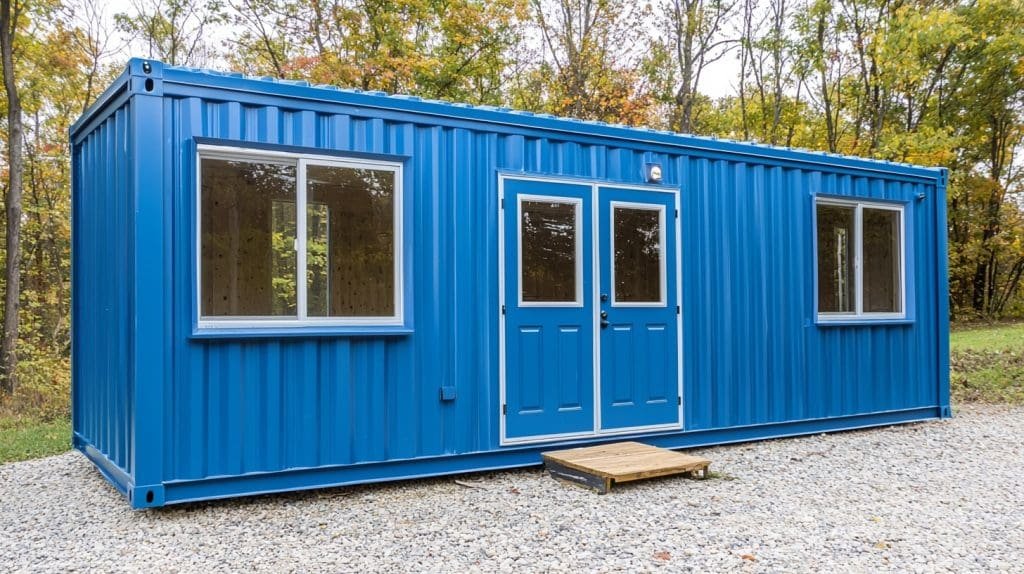
What Are Pre-Designed Homes?
Pre-designed homes are a type of prefab house that comes with a fixed, standardized design, ready for quick assembly upon delivery to the site. Unlike custom-built homes, pre-designed homes are built using a set of pre-established plans that are typically less expensive and faster to produce. These homes offer a straightforward, cost-effective housing solution without compromising on quality. With fixed layouts, buyers can still choose from a variety of finishes, materials, and configurations to fit their personal needs, ensuring a balance of affordability and functionality. Saman Portable’s pre-designed homes and container houses are designed to offer flexibility while keeping costs low and construction times minimal.
The simplicity of pre-designed homes makes them ideal for buyers looking for a more affordable alternative to custom-built houses. These homes are perfect for anyone who wants to move into a new space quickly without the long construction timelines and high costs associated with traditional building methods. By choosing from available plans and customizing finishes, homeowners can still get a house that suits their tastes, all while sticking to a budget.
Benefits of Choosing Pre-Designed Homes
Pre-designed homes provide a wealth of benefits, especially for buyers on a budget or those in need of a quick housing solution. One of the key advantages is cost savings. Since the designs are already created, there is less planning and design work required, reducing both architectural fees and the overall cost of construction. The factory-controlled environment ensures consistent quality, and since the designs are already tested, they can be quickly adapted and delivered without additional design delays.
In addition to cost savings, pre-designed homes are faster to build and install than custom homes, making them an excellent option for those in need of immediate housing. Whether you’re looking for a portable cabin or a larger modular unit, the streamlined production and assembly process means less time spent waiting for construction to be completed. This allows homeowners or businesses to move into their new space in a fraction of the time compared to traditional housing options.
Perfect for Budget-Conscious Buyers Without Compromising Quality
Pre-designed homes are the ideal solution for those who need an affordable yet high-quality living space. The fixed designs eliminate the complexity and high costs of bespoke planning, while still offering quality materials and efficient construction processes. Buyers can rest assured that these homes will provide long-lasting durability and energy efficiency, just like custom-built homes. Saman Portable’s prefabricated housing solutions, including modular homes, offer a wide range of options for budget-conscious buyers, making it easier to find a home that fits their needs without breaking the bank.
By choosing a pre-designed home, buyers can also take advantage of the sustainability benefits of prefab construction. The energy-efficient designs and use of eco-friendly materials help reduce the environmental impact, all while providing a practical, affordable living space.
In conclusion, pre-designed homes are an excellent option for anyone seeking affordable, high-quality housing that doesn’t require lengthy construction times or excessive costs. These homes offer a practical solution for individuals, families, or businesses looking to quickly and efficiently set up a comfortable living or working space. Saman Portable’s range of prefabricated homes provides flexible, customizable options that meet both budgetary constraints and long-term needs.
Luxury Prefab Homes for Premium Budgets
Features of High-End Prefab Homes
Luxury prefab homes are designed to combine high-end finishes, advanced technology, and sustainable practices, providing a premium living experience at a fraction of the time and cost of traditional luxury homes. These homes often feature spacious floor plans, custom layouts, high-end interior finishes, and state-of-the-art appliances, making them ideal for those who seek the best in comfort, style, and functionality. Saman Portable’s container homes and other high-end modular options offer luxury prefab homes that can be tailored to suit a range of tastes, from contemporary minimalist designs to more classic, traditional styles.
In addition to their stunning designs, luxury prefab homes are often built with advanced insulation, energy-efficient windows, and sustainable materials, ensuring that homeowners enjoy both comfort and energy savings. These homes are designed with the modern buyer in mind, providing a luxurious living environment that doesn’t compromise on sustainability or functionality. Features such as solar panels, smart home systems, and eco-friendly materials are commonly incorporated into these homes to enhance both convenience and environmental responsibility.
Customizable Layouts and Design for Premium Living
One of the key advantages of luxury prefab homes is the ability to fully customize the design and layout to fit personal preferences. Buyers can select everything from the number of bedrooms and bathrooms to the layout of the kitchen, living areas, and outdoor spaces. This level of customization ensures that the luxury prefab home is perfectly suited to the owner’s unique needs and lifestyle. Whether you’re looking for expansive open-plan living areas, dedicated spaces for home offices, or integrated outdoor entertainment areas, modular housing offers flexibility and adaptability.
Saman Portable’s modular homes allow buyers to choose finishes, materials, and features that elevate the aesthetics and functionality of the space. From luxury flooring and designer kitchens to built-in smart technology systems, the options are virtually endless for creating a high-end living experience. The ability to create a fully customized, luxury home at a faster rate and more affordable price than traditional luxury homes makes prefab homes an attractive alternative for those with discerning tastes.
Benefits of Choosing Luxury Prefabricated Homes
Luxury prefab homes offer the same comfort and design as traditional luxury houses, but they come with several advantages, such as quicker construction times and lower costs. Since the bulk of the construction is done in a factory setting, there is much less time spent on-site, meaning that homeowners can move in much faster. This quick turnaround also helps buyers save on labor costs and the ongoing expenses associated with traditional homebuilding.
Moreover, luxury prefab homes are designed to be energy-efficient and low-maintenance, providing long-term savings and reducing the environmental impact of the home. Features such as advanced HVAC systems, energy-efficient insulation, and eco-friendly building materials make these homes an attractive option for buyers who are looking for both luxury and sustainability. By opting for a prefabricated home, buyers can enjoy the elegance and comfort of a high-end property while minimizing energy consumption and ongoing maintenance costs.
In conclusion, luxury prefab homes offer a premium, customizable living experience without the high costs and lengthy construction times typically associated with traditional luxury homes. Whether you choose a container-based home or a fully customized modular home, prefab homes deliver the perfect blend of style, functionality, and efficiency. These homes provide high-end features and innovative designs, giving buyers a luxurious living space that meets their lifestyle and budgetary needs.
Cost Comparison: Prefab Homes vs. Traditional Homes
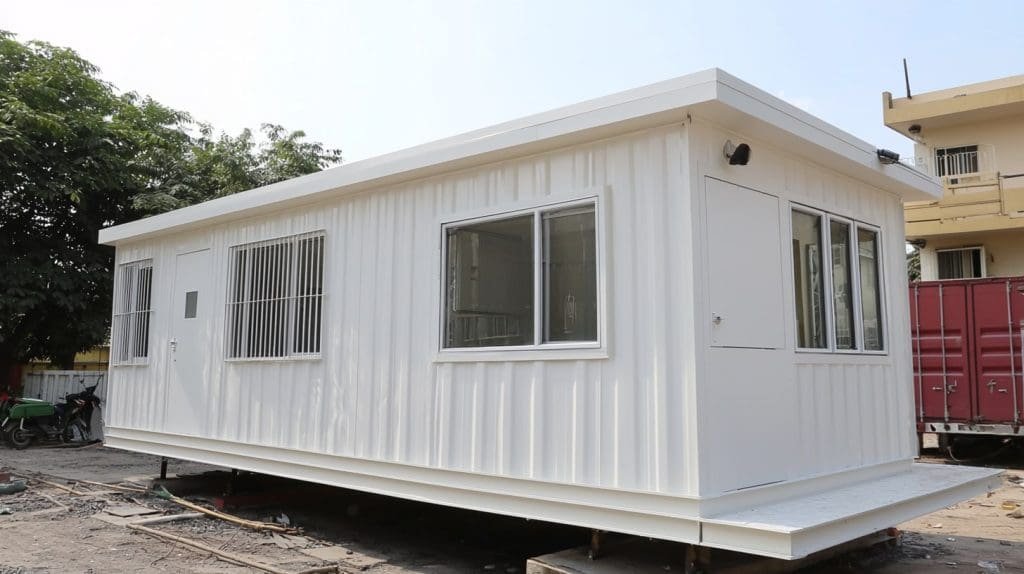
Lower Construction Costs with Prefabricated Homes
One of the most attractive advantages of prefabricated homes is their ability to offer substantial cost savings when compared to traditional homes. Traditional housing projects often involve a lengthy construction process, unpredictable delays, and significant labor costs, all of which contribute to a higher overall price. In contrast, prefab homes, such as Saman Portable’s container homes and modular homes, are manufactured off-site in a controlled factory setting, reducing the need for extensive on-site labor and materials. The manufacturing process is more efficient, and material waste is minimized, which lowers the overall cost of construction.
Additionally, prefab homes typically require less time to assemble on-site, which translates to fewer labor hours and reduced costs associated with construction delays. Since the components are prefabricated to precise specifications, the risk of errors or complications during assembly is significantly lower, further reducing expenses. This efficiency allows for more affordable pricing, making prefab homes a budget-friendly option for those looking to invest in quality housing without breaking the bank.
Long-Term Savings on Maintenance and Energy Costs
In addition to lower initial construction costs, prefabricated homes provide significant long-term savings. These homes are built with durable materials and energy-efficient features that help reduce maintenance costs and energy bills. The high-quality insulation, energy-efficient windows, and weather-resistant finishes used in prefab homes contribute to better temperature regulation, lowering the need for excessive heating or cooling. This can result in substantial savings on utility bills over time.
For instance, Saman Portable’s modular housing solutions are designed with energy efficiency in mind, ensuring that your new home stays comfortable while keeping energy costs in check. With sustainable features like solar panels, efficient HVAC systems, and well-insulated walls, prefab homes are a great way to save money on energy while also contributing to a more sustainable future.
Comparing Time and Cost Efficiency of Traditional Homes vs. Prefabricated Homes
Another area where prefabricated homes outshine traditional homes is the time factor. Traditional homes typically take several months or even years to complete, depending on the scope of the project and any unforeseen delays. In contrast, prefab homes can be assembled within weeks, with much of the construction process already completed in the factory. This rapid turnaround is a major advantage for buyers who need to move into their new home quickly or businesses that require fast, reliable housing or office solutions.
Prefab homes also allow for easier scaling, whether it’s adding more space or adapting to new needs. For example, pre-designed homes and portable cabins can be expanded or reconfigured without major disruptions or expensive renovations. This flexibility, combined with faster construction and lower costs, makes prefabricated homes an excellent investment for both short-term and long-term housing needs.
In conclusion, prefabricated homes provide a cost-effective alternative to traditional housing, offering savings both in terms of initial construction costs and long-term maintenance and energy bills. With quicker construction times, lower labor and material costs, and energy-efficient designs, prefab homes like Saman Portable’s container homes deliver exceptional value for homeowners and businesses alike. By choosing prefab homes, buyers can enjoy high-quality, affordable housing without the complications and costs typically associated with traditional construction.
Environmental Benefits of Prefabricated Homes
Sustainable Building Practices in Prefabricated Housing
Prefabricated homes are a more sustainable option compared to traditional construction methods due to their efficient production process and the use of eco-friendly materials. The factory-controlled environment ensures that materials are used efficiently, reducing waste. In traditional construction, leftover materials are often discarded, contributing to significant environmental waste. However, in prefabricated housing, the precise manufacturing process minimizes material waste and optimizes the use of resources, making it a more sustainable alternative.
Furthermore, prefabricated homes are often constructed with environmentally friendly materials, such as recycled steel, eco-friendly insulation, and sustainably sourced wood. These materials reduce the carbon footprint of the construction process while ensuring that the final product is durable and long-lasting. By choosing prefab homes, homeowners can contribute to a greener future without compromising on quality or comfort. Saman Portable’s prefabricated housing solutions include the use of these sustainable materials, ensuring both durability and eco-friendliness.
Energy Efficiency and Reduced Carbon Footprint
Energy efficiency is a key consideration in the design of prefab homes. Many modular homes come with advanced insulation, energy-efficient windows, and high-performance HVAC systems, which help regulate temperature and reduce energy consumption. This makes them more environmentally friendly than traditional homes, which may have less efficient heating and cooling systems. By incorporating green technologies such as solar panels and rainwater harvesting systems, prefab homes can significantly lower utility costs while minimizing their impact on the environment.
Saman Portable’s container homes and other prefab units are designed with energy efficiency in mind, providing a sustainable, low-maintenance living solution. With features like advanced insulation and energy-efficient windows, these homes are designed to maximize energy savings and minimize the need for artificial heating and cooling, making them an excellent choice for environmentally conscious homeowners.
Reducing Construction Waste and Impact on the Environment
One of the most significant environmental advantages of prefabricated housing is the reduction in construction waste. Since prefab homes are built off-site, the majority of the construction is completed in a controlled environment where waste can be minimized. Unlike traditional construction, where excess materials often end up in landfills, prefab homes are produced with precision, and any leftover materials are recycled or reused in the next build. This approach helps conserve resources and reduces the overall environmental footprint of the construction process.
Prefab homes also require fewer on-site resources, such as water and power, reducing the environmental strain typically caused by long, on-site construction projects. Additionally, the fast construction process of prefabricated homes means that the environmental disturbance caused by construction is minimized, reducing the impact on the local ecosystem. Saman Portable’s modular housing options are built with these sustainable practices in mind, ensuring that the process of building your new home is as environmentally responsible as the home itself.
In conclusion, prefabricated homes offer significant environmental benefits by reducing waste, improving energy efficiency, and utilizing sustainable building practices. By choosing prefab homes, homeowners can enjoy a comfortable, high-quality living space that contributes to a greener future. With reduced carbon footprints, energy-efficient features, and sustainable construction methods, prefab homes like Saman Portable’s prefabricated housing solutions are an excellent choice for those looking to live more sustainably.
Reduced Environmental Impact: The Green Benefits of Modular Homes
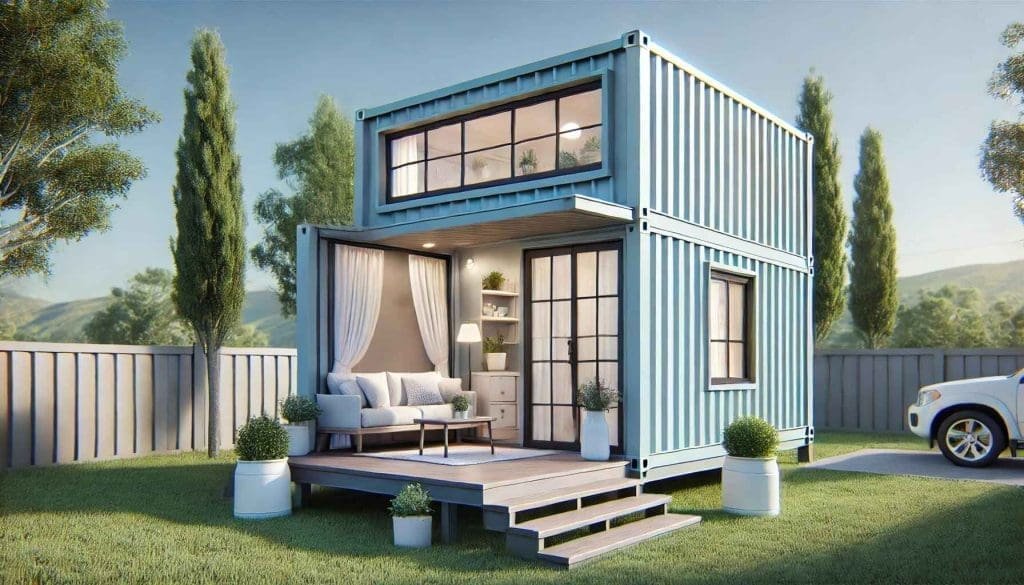
Minimizing Construction Waste and Material Usage
One of the most significant environmental advantages of modular homes is the reduced waste generated during construction. Unlike traditional building methods that often result in considerable amounts of discarded materials, prefab homes are manufactured in a controlled factory setting where materials are carefully measured, cut, and used with precision. This process ensures that there is minimal waste, with excess materials either being recycled or used in future builds. Additionally, factory-based production reduces the need for on-site construction activities, which helps to limit the environmental disruption typically associated with traditional construction.
By cutting down on material waste and minimizing unnecessary resource consumption, prefab homes are a sustainable option for those looking to reduce their environmental footprint. For example, Saman Portable’s container homes and prefabricated housing units are made with eco-friendly materials, ensuring that the construction process is as environmentally responsible as the final product.
Energy-Efficient Design and Reduced Carbon Footprint
Prefab homes are often designed with energy efficiency in mind, which helps reduce their carbon footprint. From superior insulation to energy-efficient windows, modular homes can maintain a comfortable indoor temperature with less reliance on heating and cooling systems. Many prefab homes are built with advanced building technologies like solar panels, rainwater harvesting systems, and energy-efficient appliances, further decreasing energy consumption and contributing to a greener lifestyle.
Saman Portable’s modular homes incorporate these features to provide energy-efficient solutions that lower utility bills while promoting sustainability. By reducing energy consumption, prefab homes contribute to a significant reduction in the carbon footprint, making them an eco-friendly choice for those looking to live in a more sustainable way.
Sustainability in Prefabricated Housing Materials
Prefabricated homes also use sustainable materials that are environmentally friendly and energy-efficient. Many of the materials used in prefab homes, such as recycled steel, wood sourced from sustainable forests, and low-VOC paints, are chosen for their minimal impact on the environment. These materials not only help reduce the carbon footprint of the construction process but also ensure that the finished product is built to last with minimal maintenance.
Prefab homes can also be designed with energy-efficient insulation, sustainable roofing materials, and eco-friendly flooring options, contributing to a healthier living environment. By choosing prefab homes like Saman Portable’s prefabricated housing solutions, homeowners can ensure that their homes are built using responsible materials and processes that benefit both the planet and their long-term well-being.
In conclusion, modular homes are a greener alternative to traditional housing due to their reduced construction waste, energy-efficient design, and use of sustainable materials. With the growing focus on sustainability and eco-friendly practices, prefabricated homes offer a responsible solution for buyers looking to reduce their environmental impact. Whether you choose a portable cabin or a larger modular unit, prefab homes provide a sustainable, eco-conscious living option without sacrificing comfort or quality.
Choosing the Right Prefabricated Home for Your Budget and Needs
Key Considerations When Choosing a Prefabricated Home
When selecting a prefabricated home, it’s important to consider several factors to ensure the home meets your needs, lifestyle, and budget. First and foremost, the modular housing design in India offers a range of sizes, layouts, and customization options, which means you can select a prefab home that fits your space requirements. Whether you’re looking for a compact portable cabin for temporary use or a larger, more permanent modular home, the variety of options available allows you to choose the perfect design for your lifestyle.
Your budget is another crucial factor. While prefabricated homes are generally more affordable than traditional homes, the costs can vary depending on factors such as size, customization, and additional features. Understanding the costs of the various prefab options, such as pre-designed homes or modular homes, will help you make an informed decision. Saman Portable’s range of prefabricated homes allows you to find a solution that fits both your financial and housing needs.
Assessing Space and Layout Requirements
Another key consideration is the layout and space you need. Prefabricated homes come in a variety of configurations, from simple single-room units to expansive multi-room homes. If you have a growing family or need space for an office, for example, you’ll want to explore modular homes that offer more room and flexible layouts. Saman Portable offers container homes that provide adaptable floor plans that can be customized to suit your needs, whether for personal use or as a commercial office space.
Modular homes can also be expanded or reconfigured over time, providing further flexibility for future needs. Whether you need more living space in the future or want to adjust the home to meet new requirements, the modular construction approach allows for easy adaptation.
Choosing Between Pre-Designed and Custom Homes
For those on a tighter budget or who need a quick solution, pre-designed homes are a great option. These homes offer standard layouts that can be modified with different finishes and materials. They are typically more affordable and faster to build, making them ideal for people who need a functional home without the additional costs of custom design. On the other hand, modular housing offers a higher level of customization, allowing you to choose from a variety of layouts and design elements, including room sizes, materials, and energy-efficient features.
Saman Portable’s portable cabins and modular homes provide flexible solutions for those who need a personalized touch while keeping costs within budget. Whether you’re looking for a simple, functional home or a high-end modular house, there are prefab options available for all budgets and preferences.
In conclusion, choosing the right prefabricated home depends on understanding your space requirements, budget, and the level of customization you need. Whether you go with a pre-designed home or opt for a fully customized modular home, prefab homes provide a variety of solutions that cater to different needs and financial situations. With quick installation, energy-efficient features, and the option for expansion, prefab homes offer a versatile and cost-effective housing solution. For more information on Saman Portable’s prefabricated options, visit their about us page.
The Future of Modular Housing in India
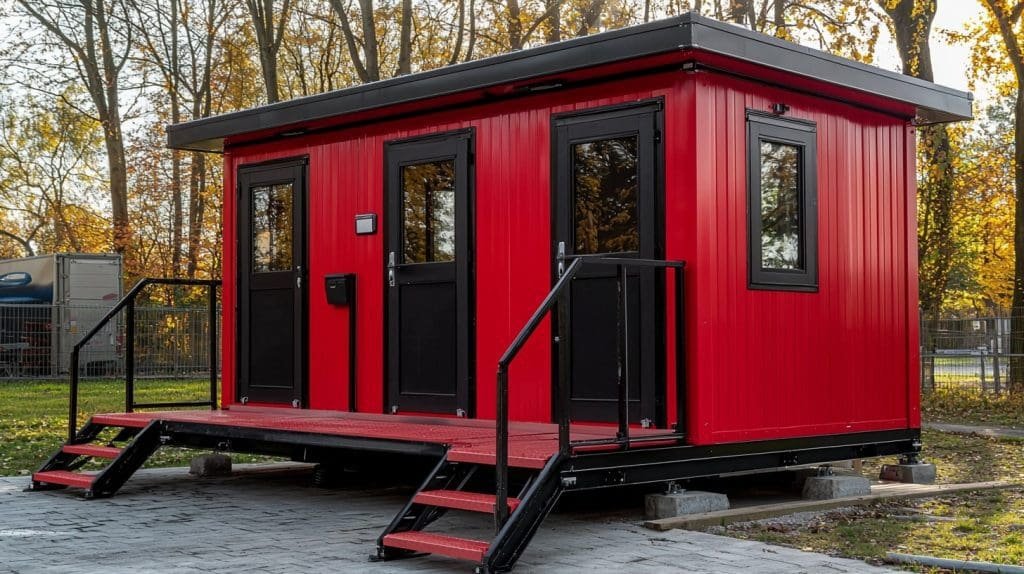
Growing Demand for Modular Housing in India
The demand for modular housing in India is expected to increase significantly in the coming years as urbanization accelerates and the need for affordable housing grows. With the rise of cities and rapid infrastructure development, more and more people are looking for cost-effective, quick-to-build housing solutions. Modular homes offer a practical solution by combining speed, affordability, and quality, making them an ideal choice for urban areas where land is limited and construction time is crucial. Saman Portable’s prefabricated housing solutions are perfectly suited to meet the growing demand for efficient, reliable, and affordable housing across India.
With more people seeking modern, sustainable housing options, modular homes offer a compelling alternative to traditional brick-and-mortar homes. The ease of customization, rapid construction process, and cost-effectiveness make prefab homes a favored choice for both residential and commercial purposes. As the Indian government also focuses on providing affordable housing, modular housing is set to play an increasingly important role in India’s housing sector.
Technological Advancements in Modular Home Construction
Advancements in technology are likely to further accelerate the growth of modular housing in India. Innovative techniques such as 3D printing and advanced robotics in construction are being integrated into prefab home production, making the construction process faster, more efficient, and cost-effective. These technological innovations not only speed up the construction time but also allow for highly precise manufacturing, ensuring top-quality products.
Saman Portable’s container homes and modular units benefit from these advancements, ensuring high standards of design and durability while also cutting down on production costs. As these technologies become more widely adopted, prefab homes will become even more accessible, offering buyers affordable housing with modern features and a high level of customization.
Sustainability and Eco-Friendly Practices in the Future of Prefabricated Homes
Sustainability is becoming a core focus of the construction industry worldwide, and the future of modular housing in India is no exception. Prefabricated homes are already recognized for their lower environmental impact compared to traditional housing, as they generate less waste and consume fewer resources during the construction process. As the demand for eco-friendly and sustainable housing solutions grows, prefab homes will incorporate even more environmentally friendly features, such as energy-efficient appliances, solar panels, water-saving technologies, and recycled materials.
Saman Portable’s prefabricated homes are designed with sustainability in mind, offering green building options like energy-efficient insulation and eco-friendly materials. As environmental regulations become stricter and the push for sustainable development increases, modular homes will continue to evolve and incorporate new technologies to meet the needs of environmentally conscious buyers.
Affordability and Accessibility for a Wider Population
As modular housing becomes more mainstream, it will become increasingly accessible to a broader range of buyers, including low- and middle-income families, small businesses, and remote communities. The affordability and quick delivery of prefab homes make them an ideal solution for those who need housing quickly and at a reasonable price. In addition, the ease of expansion and customization of modular homes means that they can be adapted to suit the growing needs of a family or business.
Saman Portable’s portable cabins and modular housing units provide affordable, customizable solutions for a variety of purposes, from residential homes to commercial spaces. As the modular housing market in India continues to grow, these homes will become an essential part of the country’s housing landscape, offering a solution to the housing shortage while keeping costs manageable for a wide range of buyers.
In conclusion, the future of modular housing in India is bright, with growing demand, technological innovations, and a strong focus on sustainability driving the industry forward. Prefabricated homes offer an efficient, cost-effective, and eco-friendly solution to India’s housing needs, making them a key player in the future of housing development in the country. With advancements in construction technology and an increasing focus on affordability and environmental responsibility, modular homes are set to play an important role in shaping India’s housing landscape. For more about Saman Portable’s commitment to providing innovative and sustainable housing solutions, visit our About Us page.
 Container Cafe
Container Cafe

















































































